Math test

如何撰写文献综述?文献综述怎么写图文教学
每天我们都有无穷的文献要看,有时候不是非要代写文献综述,自己动动手说不一定也可以做出满意的文献综述。

那么是时候写一篇文献综述了!
要不然怎么对得起我们看过的那些论文(不是
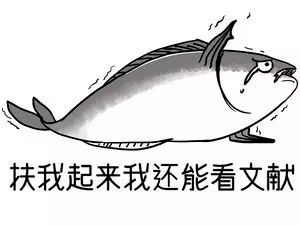
那么如何才能高效地写一篇高质量文献综述呢?
请继续读下去叭!
INTRODUCTION
A literature, or lit,review is basically a statement on where the field that you’re studyingcurrently stands. It requires researching key publications within a field andpresenting those arguments in a concise, clear section of your paper. It takessome time and research, but once you know what you’re doing, you can tackle thelit review and get on with the rest of your paper.
一篇文献综述基本上是对你正在研究的领域现状的陈述。其要求为研究某个领域内的关键出版物,并在你的论文中简明、清晰地提出这些论点。这需要我们花费一些时间,做一些研究,但一旦你知道你在做什么,你就能够完成文献综述并继续论文的其余部分啦

!
01
Evaluating Your Sources
I Locate the most recent work in the field.
In general, a literature review should be up-to-date, so your reader knows the current state of the field.
- Your library search engine is the best source for recent or classic work.
- Remember that newer publications aren’t necessarily better than older ones. But it’s important to find new work so your review is up-to-date.
- You could also check the bibliographiesin the work you’re already using or ask your professor for reading suggestions if you need more ideas.
I 找出该领域最近的文献。
一般来说,文献综述应该体现最新的学术动态,这样你的读者就能知道该领域的当前状态。
•图书馆搜索引擎是寻找最近的和经典著作的好去处!注意输入的关键词。
•记住新的刊物并不一定比旧的更好。但为了使你的文献综述更新颖,寻找新著作很重要。
•查看你在读著作中的 参考文献,如果你需要更多信息的话也可以向你的教授请教一些有关阅读的建议。
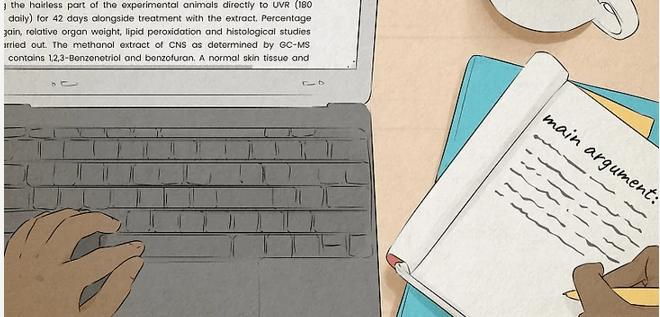
IIIdentify the main argument of each work you read.
- Try to state each argument as simply as possible. Sum up the author’ s point in a sentence , if you can.
- In most cases, you won’ t have to read the entire work to understand the author’ s argument. Some state their arguments at the beginning very clearly.
II 写出你所读文献中的每一个主要论点。
•尽可能地简单陈述该论点。如果可以的话,把作者的观点总结为 一句话。
•大多数情况下,你不需要阅读整篇文章就可以了解作者的观点。一些作者会在 文章开头将观点阐述清楚。
III Critique the sources and evidence that each author uses.
- When you’re writing your review, note how the evidence helps or hurts the author’s arguments.
- One source might use mostly newspaper articles for evidence, which aren’ t always reliable. Another might use statistical data and government studies , which are usually more reliable, and therefore this source is more convincing.
- The evidence that the author uses should also be easy to find, and they should provide clear citations and links if possible.
III 判断每个作者所用的信息来源及论据。
•在写文献综述时,你要记录作者所用的论据是如何论证论点的,是起到了积极作用还是消极作用。
•报纸文章上的信息并不总是可靠的。而 统计数据和政府研究则通常更为可靠,因此会更有说服力。
•作者所用的证据应该是很容易找到的,他们会尽可能提供清晰的引用信息和链接。
IVExamine any personal bias the author may have.
- If you’re researching music in 20th-century Europe, for example, a musician might say that they had a huge impact on the scene. The fact that this person was a musician at the time could make their opinion biased.
- Remember that all people have bias, so a biased work isn’t necessarily useless. But it’s something to note in your lit review to show that you’ve evaluated all your sources carefully.
IV 审查作者是否存在个人偏误。
•如果你在研究欧洲20世纪的音乐,例如一位音乐家可能会说他们在这一领域有巨大影响力。而这位音乐家生于这个时代,就会使他的观点有失偏颇。
•要记住每个人都有偏见,所以带有偏误的著作并不一定没用。但如果你把这些东西写进文献综述里,则能证明 你 是在认真仔细地评估所有文献来源。
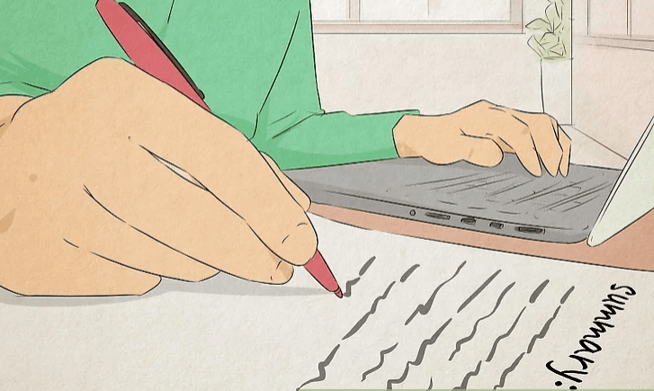
V Summarize each source so writing your review is easier.
- It’ s best to take notes while you’ re reading and jot down each author’ s argument, sources, bias, and your own thoughts on the work.
V 总结所有文献来源会使写作更加容易。
•最好在阅读过程中记下每一个作者的 观点、来源、偏误以及你自己对文章的看法。
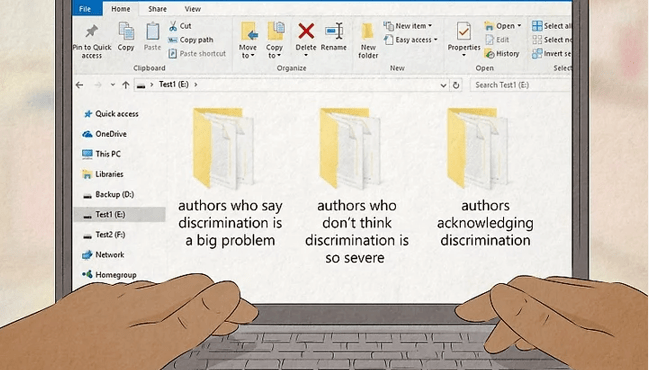
VIGroup all of your sources into categories.
When you read all of your sources, you’ll probably start seeing different themes. Some authors might agree with one another, some might directly argue with each other, and some might offer completely different perspectives.
VI 将你的文献资源归类。
读文献时,你可能会遇到不同的主题。一些作者可能会与其他人达成一致,或直接与他人争论,另一些可能提出完全相反的观点。
02
OrganizingYour Review
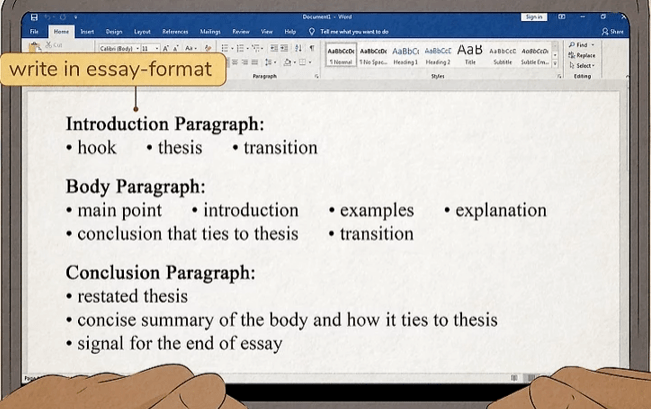
I Write your lit review in essay-format.
- If you need help organizing your thoughts, you could always start with a bullet-point list. However, you’ll need to polish this into an actual essay.
I 以文章的形式来写你的文献综述。
•如果你不知道如何组织你的想法,那么可以从 点式列表开始,但你需要把它润色成一篇完整的文章。
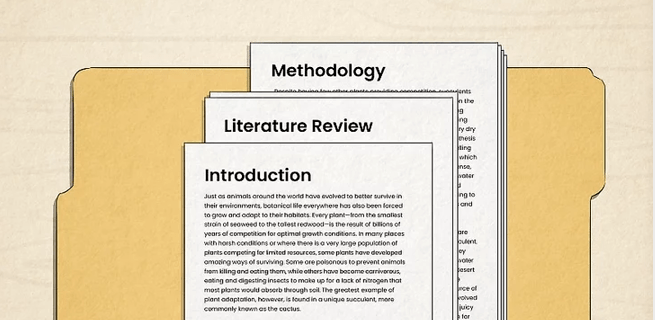
II Place the lit review between the introduction and bodyof your paper.
II 将文献综述放在引言和正文中间。
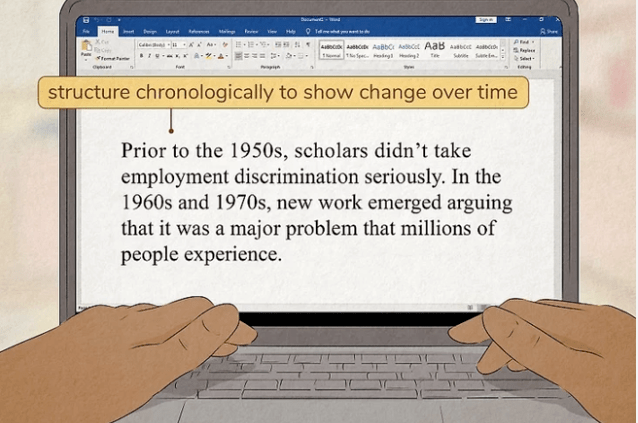
III Structure your review chronologically if you want toshow change over time.
This is helpful for works of history, sociology, and other social scienceswhere work changed considerably over time.
- Try to make some larger statements as you write chronologically. You could say, “Prior to the 1950s, scholars didn’ttake employment discrimination seriously. In the 1960s and 1970s, new work emerged arguing that it was a major problem that millions of peopleexperience.” This helps move your reader along. This is helpful for works of history, sociology, and other social sciences where work changed considerably over time.
III 如果你想表现出时间的变化,就按照时间顺序组织你的文献综述。
这对历史、社会学和其他社会科学领域的工作很有帮助,因为它们都随着时间的推移而发生了相当大的变化。
•当你按时间顺序写的时候,试着写一些更大的语句。你可以说,“在20世纪50年代之前,学者们并不重视就业歧视。在20世纪60年代和70年代,出现了新的研究,认为这是数百万人经历的一个主要问题。” 这有助于你的读者继续阅读。
03
Writing the Review
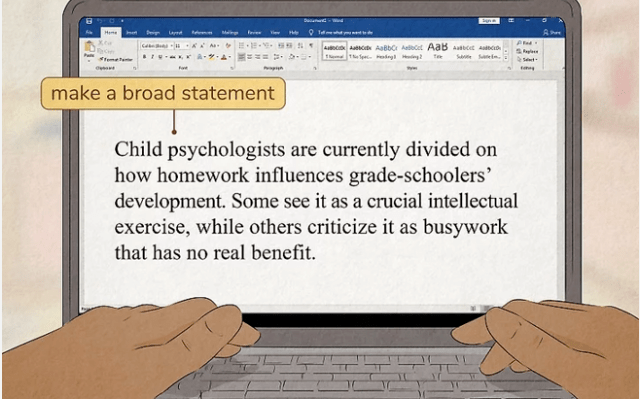
I Make a broad statement about where theliterature stands in your intro.
A literature review should have anintroduction with a thesis statement, just like any other essay. Start off yourreview with a few sentences explaining the field and what the main ideas arewithin it.
- Your statement doesn’thave to show agreement. It’s perfectly fine to say something like “Childpsychologists are currently divided on how homework influencesgrade-schoolers’ development. Some see it as a crucial intellectual exercise, while others criticize it as busywork that has no real benefit.”
I 在你的引言部分中对文献的位置做一个宽泛的陈述。
文献综述应该像其他论文一样,有一个引言和一个论题陈述。在文章开始用几句话来解释这个领域以及它的主要思想。
•你的陈述不必对其他作者表示同意。可以这样说“儿童心理学家目前对于家庭作业如何影响小学生的发展存在分歧。一些人把它看作是一种重要的智力锻炼,而另一些人则批评它为一种没有真正好处的瞎忙。”
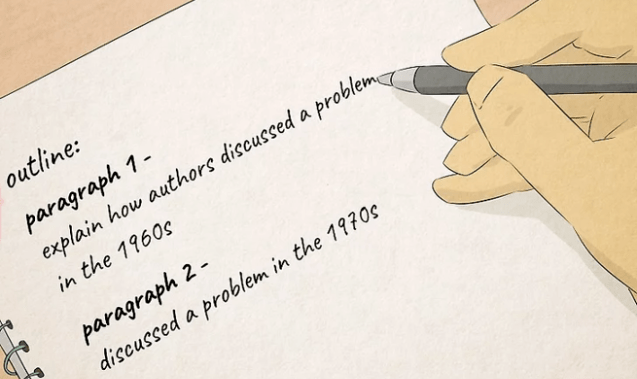
II Organize your body paragraphs around the themes that you identified.
- If you’re organizing your essay chronologically, you could break down paragraphs by decade .
- This also works if you’re proceeding thematically. You could have a paragraph about authors who support one conclusion and another about authors who disagree.
II 围绕你确定的主题组织你的主体段落。
•如果你按照时间顺序组织文章,你可以 以十年为基础来分解段落。
•如果你按主题进行,也是可以的。你可以写一段关于支持某一结论的作者的文章,另一段关于不同意该结论的作者的文章。
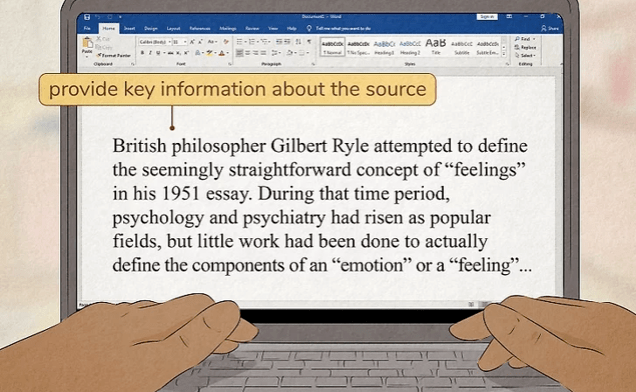
III Provide key information about each source in your review.
- Remember to show how each work fits in your main narrative. If it’s not clear why a work fits the theme you’ve placed it in, you might lose credit.
- Quotes are always good to demonstrate a point, but make sure you don’t overuse them. 1 or 2 quotes per workis plenty. Stick with your own words for the analysis.
III 在文献综述中提供有关每个文献来源的关键信息。
•记住要说明每一部作品是 如何融入你的主要内容的。如果不清楚为什么一篇文章符合你设定的主题,你可能会丢分。
•引用是证明一个观点的好方法,但确保不要过度使用。每个作品使用 1或2个引用就足够了。坚持用你自己的话进行分析。
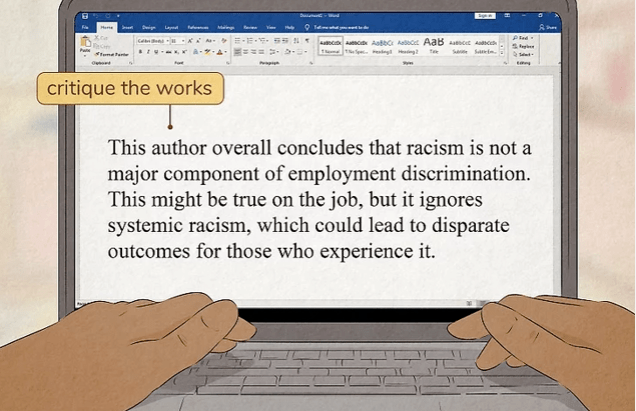
IV Critique the works to show what their shortcomings are.
State whether each work is convincing, and what the author might be leaving out.
- Be fair when you’re criticizing authors. They’ve probably researched the topic, and though you don’t agree with their conclusions, it’s not fair to act like they don’t know what they’re talking about.
IV 对文章进行评论,指出它们的不足。
说明每一部作品是否令人信服,以及作者可能遗漏的东西。
•评论时要 公平。作者们可能已经研究过这个话题,尽管你不同意他们的结论,但表现得好像他们不知道自己在说什么是不公平的。
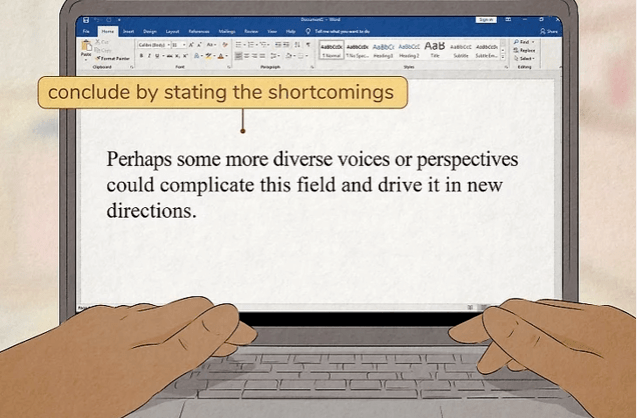
V Conclude with some questions for further research.
- You can make suggestions no matter what the review shows. If the field is divided, you could say “We clearly need more research to solve these disagreements.”If a field is united, you could say “Pehaps some more diverse voices or perspectives could complicate this field and drive it in new directions. “
- If this lit review is part of a larger researchpaper, then conclude by stating how your research solves some of these problems.
V 最后提出有待进一步研究的问题。
•无论综述内容如何,你都可以提出建议。如果这个领域观点不一致,你可以说“我们显然需要更多的研究来解决这些分歧。”如果一个领域观点是统一的,你可以说“也许更多不同的观点会使这个领域复杂化,推动它向新的方向发展。”
•如果这篇综述是一篇更大的研究论文的一部分,那么就通过陈述你的研究是如何解决这些问题的来结束文献综述部分 数学代考。
VI Stick with the length that your professorassigns.
Generally, a lit review takes up a small percentage of the overall paper, so try to keep it proportional to the work. When in doubt, ask your professor what the ideal length is.
- For a 10-20-page paper, the lit review can be afew pages. Try not to go over 2-3 unless your professor tells you to.
- In an MA thesis or PhD dissertation, the lit review might make up a whole chapter of over 20 pages.
VI 遵循教授指定的文章长度。
一般来说,一篇综述只占整篇论文的一小部分,所以尽量让它与论文成比例。
•对于一篇10-20页的论文,文献综述可能只有几页。不要超过2-3页,除非你的教授要求你这么做。
•在一篇硕士论文或博士论文中,文献综述可能会构成超过20页的整个章节。
reference
- https://writingcenter.unc.edu/tips-and-tools/literature-reviews/
- https://writingcenter.unc.edu/tips-and-tools/literature-reviews/
- https://libguides.usc.edu/writingguide/literaturereview
- https://library.concordia.ca/help/writing/literature-review.php
- https://libguides.usc.edu/writingguide/evaluatesources
- https://libguides.usc.edu/writingguide/evaluatesources
- https://writingcenter.ashford.edu/writing-literature-review
- https://writingcenter.unc.edu/tips-and-tools/literature-reviews/
- http://www.ulib.iupui.edu/guides/literature-review-self-guided-tutorial
- http://www.philau.edu/learning/INC/pdf/Writing%20a%20Literature%20Review%20SLA%20%20Arch.pdf
- https://writingcenter.unc.edu/tips-and-tools/literature-reviews/
- https://libguides.usc.edu/writingguide/literaturereview
- https://libguides.usc.edu/writingguide/literaturereview
- https://writingcenter.unc.edu/tips-and-tools/literature-reviews/
- https://writingcenter.unc.edu/tips-and-tools/literature-reviews/
- https://libguides.uwf.edu/c.php?g=215199&p=1420568
- https://libguides.usc.edu/writingguide/literaturereview
- https://libguides.usc.edu/writingguide/literaturereview
- http://www.philau.edu/learning/INC/pdf/Writing%20a%20Literature%20Review%20SLA%20%20Arch.pdf